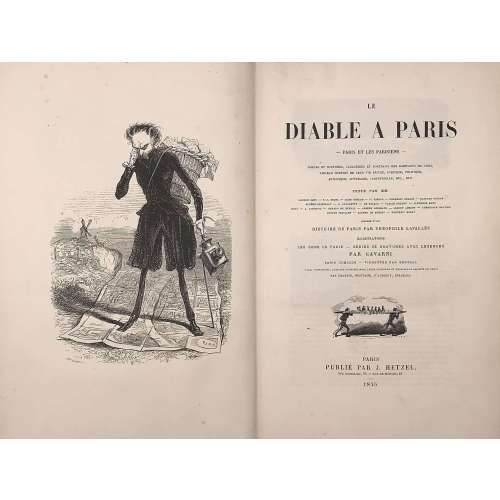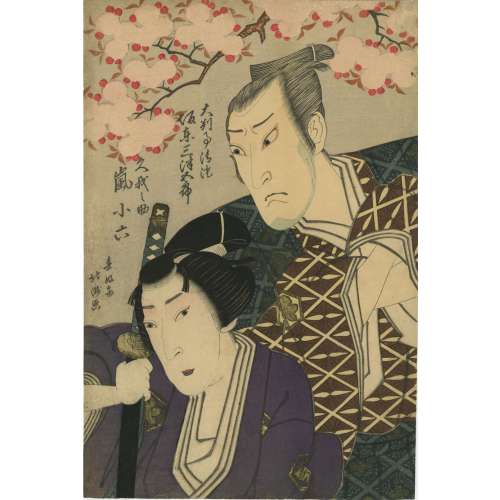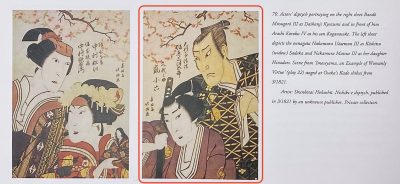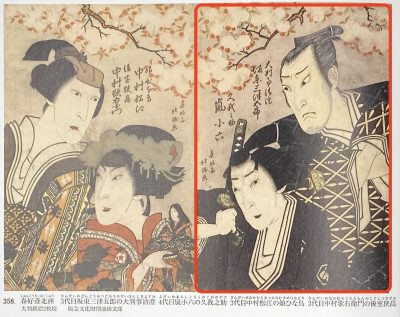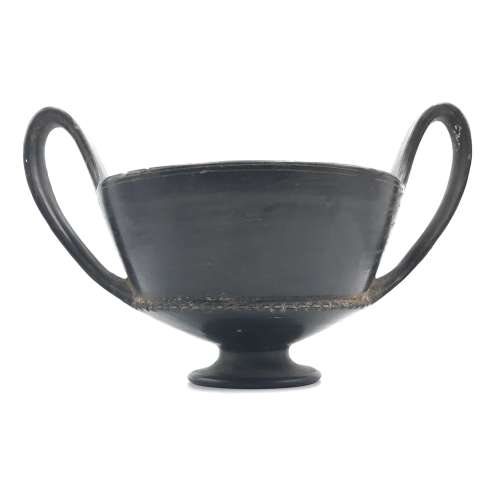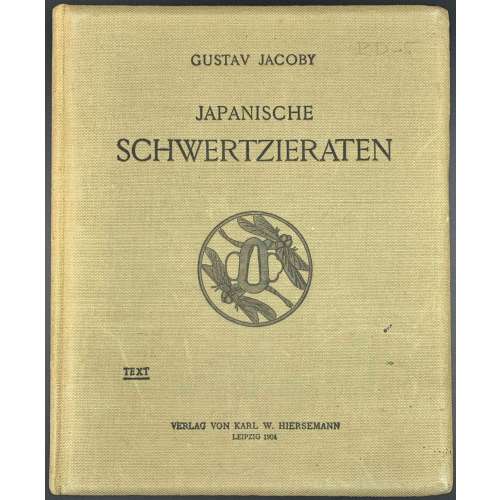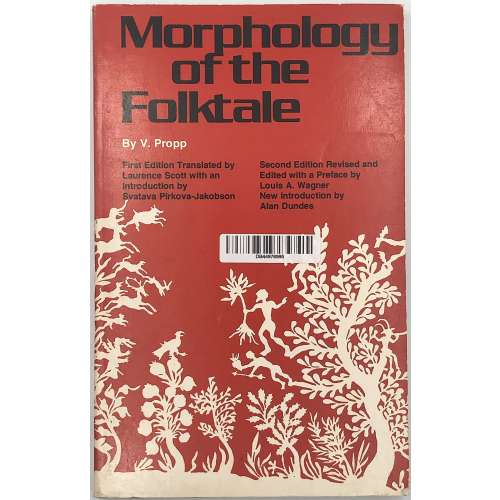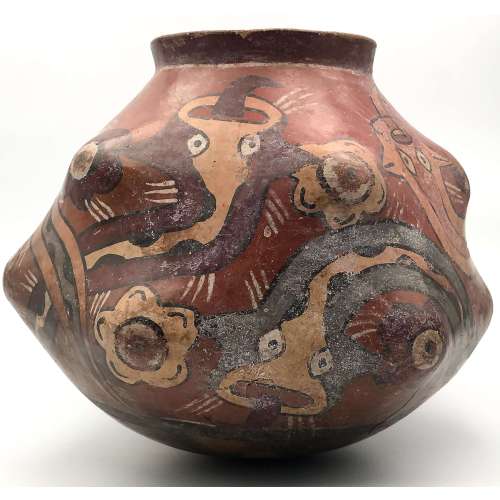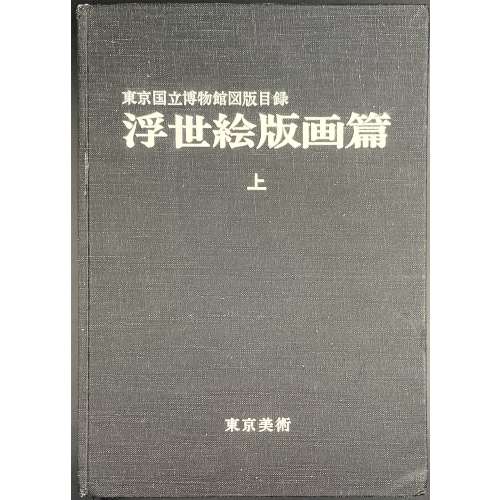A two-volume set, published in Paris by P.-J. Hetzel in 1845 and 1846.
Vol. 1:
Title: LE | DIABLE A PARIS | — PARIS ET LES PARISIENS — | MŒURS ET COUTUMES, CARACTERES ET PORTRAITS DES HABITANTS DE PARIS, | TABLEAU COMPLET DE LEUR VIE PRIVEE, PUBLIQUE, POLITIQUE, | ARTISTIQUE, LITTERAIRE, INDUSTRIELLE, ETC., ETC. | TEXTE PAR MM. | GEORGE SAND — P.-J. STAHL — LEON GOZLAN — P. PASCAL — FREDERIC SOULIE — CHARLES NODIER | EUGENE BRIFFAULT — S. LAVALETTE — DE BALZAC — TAXILE DELORD — ALPHONSE KARR | MÉRY — A. JUNCETIS — GERARD DE NERVAL — ARSÈNE HOUSSAYE — ALBERT AUBERT — THÉOPHILE GAUTIER | OCTAVE FEUILLET — ALFRED DE MUSSET — FRÉDÉRIC BÉRAT | précédé d’une | HISTOIRE DE PARIS PAR THEOPHILE LAVALLÉE | ILLUSTRATIONS | LES GENS DE PARIS — SERIES DE GRAVURES AVEC LEGENDES | PAR GAVARNI | PARIS COMIQUE — VIGNETTES DE BERTALL | VUES, MONUMENTS, EDIFICES PARTICULIERS, LIEUX CÉLÈBRES ET PRINCIPAUX ASPECTS DE PARIS | PAR CHAMPIN, BERTRAND, D’AUBIGNY, FRANÇAIS. | [DEVICE] | PARIS | PUBLIÉ PAR J. HETZEL, | RUE RICHELIEU, 76 – RUE DE MÉNARS, 10. | 1845 ||
Pagination: ffl, [2 – h.t. / Paris: Typographie Lacrampe et Comp., Rue Damiette, 2 ; Papeir de la fabrique de sainte-marie] [2 – blank / frontis. ‘Diable’ with lantern standing on map of Paris] [2 – t.p. /blank] [I] II-XXXII, [1] 2-380, bfl. Sheet size: 27.5 x 17.5 cm.
Collation: 4to; A(4) – D(4), [1(4)] 2(4) – 47(4), 48(2); illustrations: frontispiece, vignette title-page, numerous text engravings and 99 plates.
Vol. 2:
Title: LE | DIABLE A PARIS | — PARIS ET LES PARISIENS — | MŒURS ET COUTUMES, CARACTERES ET PORTRAITS DES HABITANTS DE PARIS, | TABLEAU COMPLET DE LEUR VIE PRIVEE, PUBLIQUE, POLITIQUE, | ARTISTIQUE, LITTERAIRE, INDUSTRIELLE, ETC., ETC. | TEXTE PAR MM. | DE BALZAC — EUGÈNE SUE — GEORGE SAND — P.-J. STAHL — ALPHONSE KARR | HENRY MONNIER — OCTAVE FEUILLET — DE STENDAHL — LEON GOZLAN — S. LAVALETTE — ARMAND MARRAST | LAURENT-JAN —ÉDOUARD OURLIAC — CHARLES DE BOIGNE — ALTAROCHE — EUG. GUINOT | JULES JANIN — EUGENE BRIFFAULT — AUGUSTE BARBIER — MERQUIS DE VARENNES — ALFRED DE MUSSET | CHARLES NODIER — FRÉDÉRIC BÉRAT — A. LEGOYT| précédé d’une | GÉOGRAPHIE DE PARIS PAR THEOPHILE LAVALLÉE | ILLUSTRATIONS | LES GENS DE PARIS — SERIES DE GRAVURES AVEC LEGENDES | PAR GAVARNI | PARIS COMIQUE — PANTHÉON DU DIABLE A PARIS PAR BERTALL | VUES, MONUMENTS, EDIFICES PARTICULIERS, LIEUX CÉLÈBRES ET PRINCIPAUX ASPECTS DE PARIS | PAR CHAMPIN, BERTRAND, D’AUBIGNY, FRANÇAIS. | [DEVICE] | PARIS | PUBLIÉ PAR J. HETZEL, | RUE RICHELIEU, 76 – RUE DE MÉNARS, 10. | 1846 ||
Pp. : ffl, [2 – h.t. / Paris: Typographie Lacrampe et Comp., Rue Damiette, 2 ; Papeir de la fabrique de sainte-marie] [2 – t.p. /blank] [I] II-LXXX, [1] 2-364, bfl. Sheet size: 27.5 x 17.5 cm.
Collation: 4to; A(4) – I(4) – J(4), 1(4), 2(4) – 45(4), 46(2); illustrations: vignette title-page, numerous text engravings and 112 plates.
Binding: [allegedly Roger de Coverly (British, 1831 — 1914)], 28.2 x 19 cm, ¾ brown calf ruled in gilt, brown marbled boards, nonpareil marbled endpapers, raised and ruled in gilt bands, floral devices and title lettering to spine. AEG. Foxing to flyleaves, tips of corners just a very little rubbed as are the glazed marbled paper boards; endpapers foxed; very occasional light scattered foxing of text.
Provenance: (1) Armorial bookplate (Ex Libris Sir John Whittaker Ellis, 1st Baronet (1829 – 1912), Lord Mayor of London 1881; (2) Bookplate Ex Libris Robert Frederick Green) dated 1909.
Reference: L. Carteret (1927) pp. 203-207: the first edition, lacking the publisher's white pictorial wrappers.
 Other similar specimens can be found at:
Henri L. Joly and Kumasaku Tomita, Japanese art and handicraft, "Swords and sword fittings" section, sub-section “Inlays of Ōnin, Kyoto, Fushimi-Yoshiro, and Kaga Province”, Plate CX, #128: Iron, chrysanthemoid, thin guard with alternate petals covered with brass spots. Ōnin style. 16th century.
Other similar specimens can be found at:
Henri L. Joly and Kumasaku Tomita, Japanese art and handicraft, "Swords and sword fittings" section, sub-section “Inlays of Ōnin, Kyoto, Fushimi-Yoshiro, and Kaga Province”, Plate CX, #128: Iron, chrysanthemoid, thin guard with alternate petals covered with brass spots. Ōnin style. 16th century.
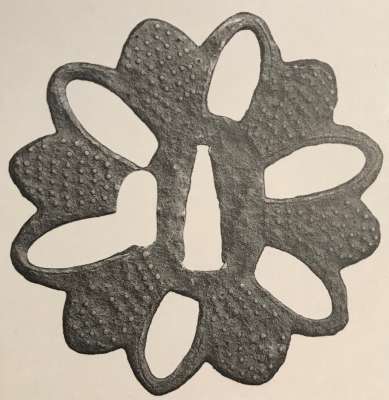



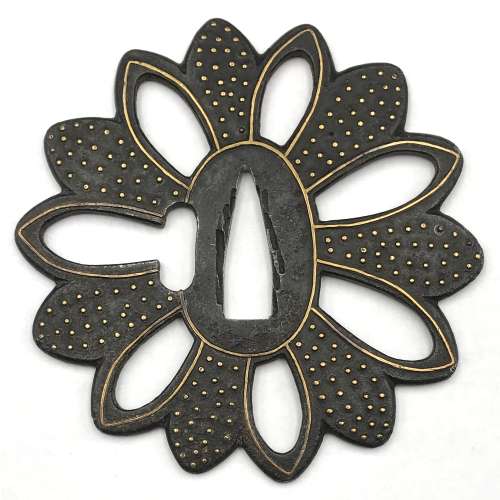

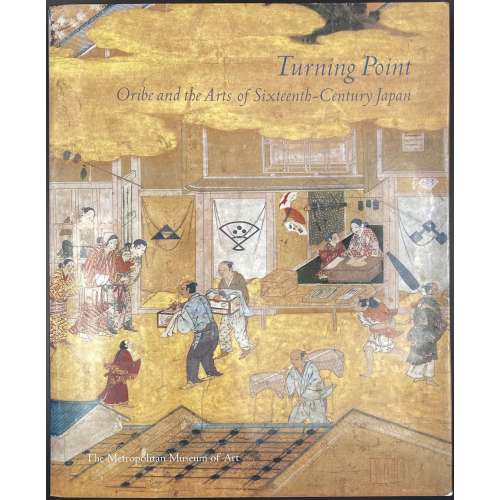
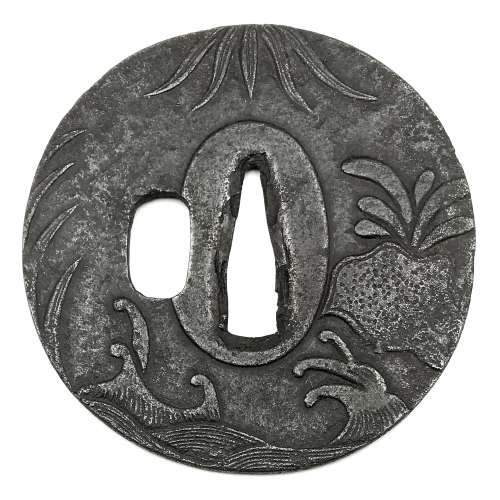

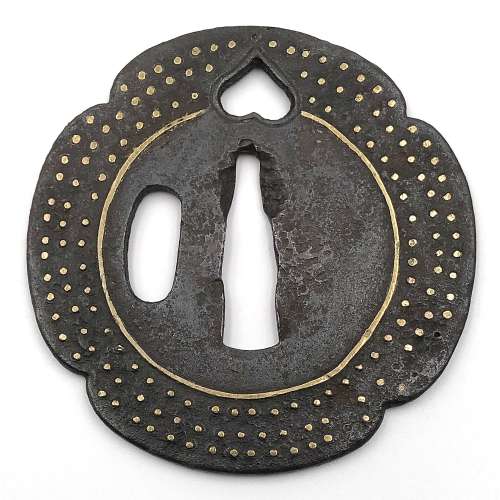
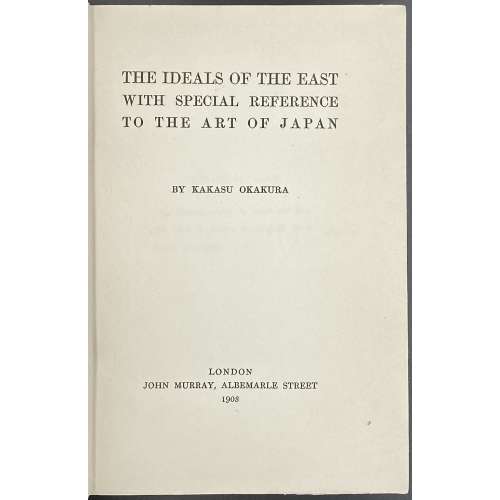
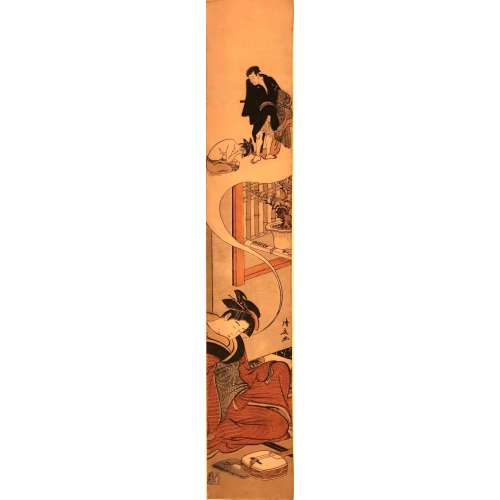
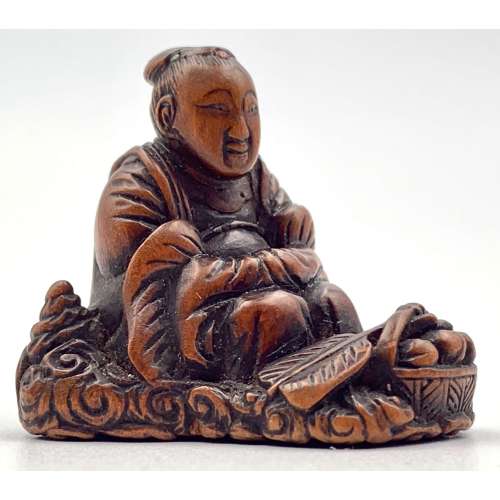
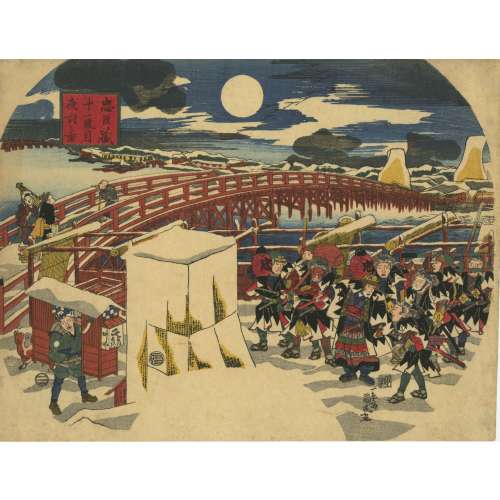
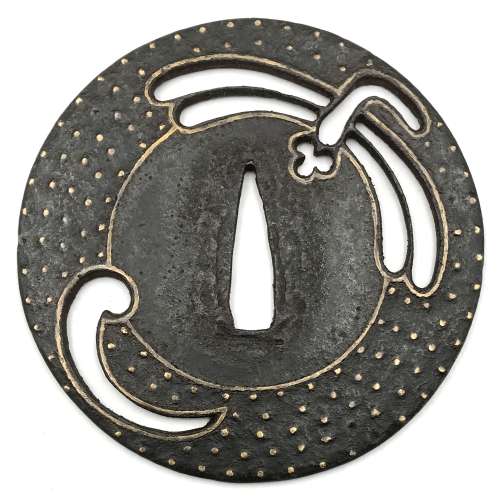
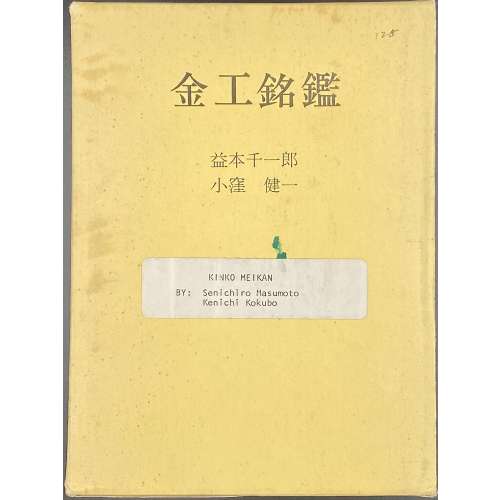
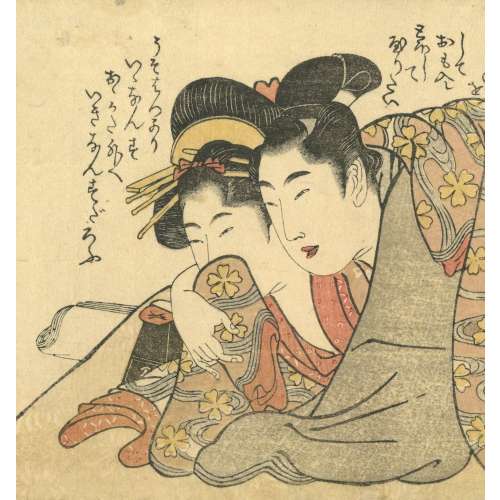
 As Japanese Erotic Fantasies put it: "a couple engaged in love-making, their stare fixed outside the picture plane". This is the only image of series that has a reference in available western literature, and the only one found in museum collections: Rijksmuseum Amsterdam (RP-P-1999-2001-16); reference: Fukuda (ed.) (1990), pls. 11-2.
As Japanese Erotic Fantasies put it: "a couple engaged in love-making, their stare fixed outside the picture plane". This is the only image of series that has a reference in available western literature, and the only one found in museum collections: Rijksmuseum Amsterdam (RP-P-1999-2001-16); reference: Fukuda (ed.) (1990), pls. 11-2.
 The scene of this print looks quite similar to that of the Kiyonaga's Sode no maki:
The scene of this print looks quite similar to that of the Kiyonaga's Sode no maki:
 The woman is "a young lady-in-waiting of Shogun's Court or Daimyō's Mansion, enjoying a rare outing from her tedious chores" [Richard Lane]. She is fully dressed in her outer cloak (shikake), white paper hat (agebōshi or tsunokakushi), and toed socks (tabi). A book or maybe, onkotogami (roll of tissues known as 'paper for honourable act' ) is still in the folds of her kimono. She is holding an open fan, either to cover her and her lover's faces from an unsolicited witness or to bring some fresh air to their joined lips. The pair just started their sexual intercourse.
The woman is "a young lady-in-waiting of Shogun's Court or Daimyō's Mansion, enjoying a rare outing from her tedious chores" [Richard Lane]. She is fully dressed in her outer cloak (shikake), white paper hat (agebōshi or tsunokakushi), and toed socks (tabi). A book or maybe, onkotogami (roll of tissues known as 'paper for honourable act' ) is still in the folds of her kimono. She is holding an open fan, either to cover her and her lover's faces from an unsolicited witness or to bring some fresh air to their joined lips. The pair just started their sexual intercourse.
 A scene from medieval times. A courtier in eboshi cap having sex with an aristocratic young woman with a long straight hairstyle (suihatsu).
A scene from medieval times. A courtier in eboshi cap having sex with an aristocratic young woman with a long straight hairstyle (suihatsu).
 Completely naked couple in the moment of ejaculation. Lavish garments with paulownia leaves on a yellow background counterbalance the white bodies on red bedding. The form of a woman's cheeks is telling, but I don't know about what. Maybe her advanced age?
Completely naked couple in the moment of ejaculation. Lavish garments with paulownia leaves on a yellow background counterbalance the white bodies on red bedding. The form of a woman's cheeks is telling, but I don't know about what. Maybe her advanced age?
 The pose of the couple and the overall composition are similar to that of the previous sheet. Though the lovers are dressed, and the woman's hairdo is well kept. The male looks older and the woman - younger.
The pose of the couple and the overall composition are similar to that of the previous sheet. Though the lovers are dressed, and the woman's hairdo is well kept. The male looks older and the woman - younger.
 A man takes a young maid from behind. She clenches the sleeve of her kimono in her teeth; it's either the moment of penetration (beginning of intercourse) or of her orgasm (the end of it).
A man takes a young maid from behind. She clenches the sleeve of her kimono in her teeth; it's either the moment of penetration (beginning of intercourse) or of her orgasm (the end of it).
 This seems to be a forced intercourse between a lackey with extensive bodily hair and a young maid from the same household.
This seems to be a forced intercourse between a lackey with extensive bodily hair and a young maid from the same household.
 This design is very much like the other one presented below, which is described at Japanese Erotic Fantasies on page 136 (pl. 43b) as follows: "The viewer peers through a mosquito net to see a child fast asleep, while his mother or wet-nurse moves towards her partner. On our print there is no child; instead of a sleeping baby, there is a roll of onkotogami. Fewer objects make the overall image concise, almost laconic in comparison with the Ehon hana fubuki (1802) design:
This design is very much like the other one presented below, which is described at Japanese Erotic Fantasies on page 136 (pl. 43b) as follows: "The viewer peers through a mosquito net to see a child fast asleep, while his mother or wet-nurse moves towards her partner. On our print there is no child; instead of a sleeping baby, there is a roll of onkotogami. Fewer objects make the overall image concise, almost laconic in comparison with the Ehon hana fubuki (1802) design:

 A young couple in a moment of true love. He is listening to the beating of her heart.
A young couple in a moment of true love. He is listening to the beating of her heart.
 This is a moment of true love between an old monk and a young samurai. The latter even did not take of his socks (tabi).
This is a moment of true love between an old monk and a young samurai. The latter even did not take of his socks (tabi).
 From Japanese Erotic Fantasies: "Boats played a crucial role in the workings of Yoshiwara, as they were the primary means of transport to the district. During the hot summer months, trips on pleasure boats were also a favourite pastime. Sex aboard a boat is a recurrent theme in shunga".
The last print that I am currently lacking and hunting for:
From Japanese Erotic Fantasies: "Boats played a crucial role in the workings of Yoshiwara, as they were the primary means of transport to the district. During the hot summer months, trips on pleasure boats were also a favourite pastime. Sex aboard a boat is a recurrent theme in shunga".
The last print that I am currently lacking and hunting for:
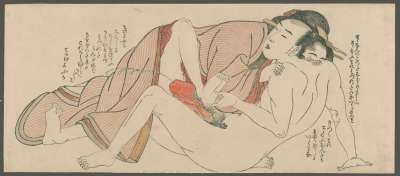 I know where it is, but I cannot reach it... yet.
I know where it is, but I cannot reach it... yet. 